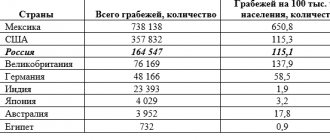There is no concept of “continuing crime of the Criminal Code of the Russian Federation”.
At the same time, a number of articles of the Criminal Code provide for liability for those acts that occur systematically or involve no action at all. It is possible to distinguish between ongoing and continuing criminal offenses, and practice shows that this is successfully implemented within the framework of unified complex offenses. Multi-channel free hotline Legal advice on criminal law. Every day from 9.00 to 21.00
Moscow and region: +7 (495) 662-44-36
St. Petersburg: +7 (812) 449-43-40
What is a continuing and ongoing crime
In order to characterize ongoing and continuing criminal acts, it is necessary to turn to the original source. The Criminal Code of the Russian Federation does not define a continuing violation, nor does it contain a definition of a continuing violation. These types are described in the Resolution of the Plenum of the USSR Armed Forces in 1961 and are used for the norms of the current criminal legislation.
Based on the name of a continuing offense, it is clear that the main feature of limiting it from a continuing unlawful action is a continuous time interval within which various actions were systematically carried out aimed at oppressing legal orders. But the Criminal Code also knows cases where negligent or intentional inaction was also an indicator of a denial of the law.
A continuing offense of the Criminal Code of the Russian Federation, in contrast to the previous type, represents the commission of different, but similar in composition, actions, which consequently lead to their definition as a crime. These illegal acts must also be carried out over a long period of time.
If a person steals a large number of items at a time, for example, a ton of cement, then he is charged with the appropriate composition. However, if he steals one bag at a time for the purpose of further using the total volume of the stolen goods, for example, for the construction of a barn, then the act is recognized as continuing regardless of the moment of discovery of the theft.
When citing examples of criminal attacks, one cannot ignore Article 205 of the Criminal Code of the Russian Federation (murder). Such an action cannot be ongoing or ongoing, as it poses a social danger to society.
In general, we can name the main characteristics of these types of socially dangerous acts:
- Lasting can be represented by both action and inaction.
- What is continued is manifested only in the action of the criminal.
- The nature of the actions of a continued action can only be intentional, while that of a continuing action cannot.
Despite the different characteristics of these types, they pursue a single goal - the commission of a socially dangerous act.
LAWYER STUCHILIN
29.09.2015
Crime scene
The article discusses the approaches used in resolving issues of determining the location of crimes.
This applies both to the implementation of the territorial principle of the criminal law and to the choice of place for conducting the preliminary investigation of a criminal case. Recently, on the pages of the magazine there has been a discussion about determining the location of fraud using telephones, as well as electronic forms of payments. The problem identified by the authors in relation to these crimes is not new for practitioners; it is actively discussed in the scientific literature. This is due to the fact that the issues raised concern not only criminal fraud, but also other criminal acts - unlawful attacks committed in the field of computer information, terrorist crimes, as well as those related to the illicit trafficking of narcotic drugs and psychotropic substances, environmental crimes, etc. .d. Many of these crimes have such properties as globality and transboundary nature, therefore they can be committed on the territory of not only different subjects of the Russian Federation, but also several countries.
The correct determination of the place where the crime was committed depends on the solution of not only legal issues - the implementation of the territorial principle of the criminal law, but also procedural ones - determining the place of the preliminary investigation, as well as the consideration of the criminal case by the court.
In the first case, priority should be given to national interests, therefore, if at least part of the actions are performed or socially dangerous consequences occur on the territory of the Russian Federation, the criminal act falls under the jurisdiction of the Russian Federation. As N. Pikurov rightly notes, the decisive idea should be the maximum protection of public and state interests, the legitimate interests of citizens of the Russian Federation, stateless persons permanently residing in the Russian Federation, legal entities registered in the Russian Federation or carrying out legal activities on its territory.
A slightly different approach, it seems, should be used when determining the location of a crime committed on the territory of different subjects of our country or other administrative-territorial units (for example, districts in a city).
According to the general rule provided for in Part 1 of Art. 152 of the Code of Criminal Procedure of the Russian Federation, a preliminary investigation must be carried out where the act containing signs of a crime was committed. From this we can conclude that the solution to this issue depends on the design of the crime - whether it is formal, material or truncated. That is, in some cases, a crime is considered completed when a socially dangerous act is committed (formal elements), in others - when consequences occur (material elements) or the moment of the end of the crime is postponed to the beginning of the commission of actions (truncated elements).
On the one hand, in accordance with the requirements of Part 2 of Art. 152 of the Code of Criminal Procedure, if a crime was started in one place and ended in another place, the criminal case must be investigated at the place where the crime ended.
Thus, the legislator, fixing the rules of territorial jurisdiction of criminal cases, established a formal criterion - the place where the crime ended. For the investigation, in particular, of most types of theft, the use of this approach is most optimal, since the seizure of property often coincides in place and time with the onset of consequences in the form of damage. Here there are both persons who have committed a criminal act and victims, with whom the necessary investigative actions are carried out.
For some categories of crimes, following the rule provided for in Part 2 of Art. 152 of the Code of Criminal Procedure is a kind of forced law. For example, as practice shows, it is often possible to collect and consolidate evidence of the occurrence of socially dangerous consequences in the form of environmental pollution (Articles 247, 250, 251 of the Criminal Code, etc.) only if the source of the negative impact (i.e. the place where violation of environmental regulations is carried out) is in close proximity to the place where the consequences occurred. Otherwise, it is difficult to establish and prove the existence of a causal relationship, and often it is simply impossible to do this.
However, in some criminal cases, especially with regard to thefts committed using telephones, as well as electronic forms of payments, terrorist crimes, etc., the use of the law enshrined in Part 2 of Art. 152 of the Code of Criminal Procedure, the approach to determining the place of conduct of a preliminary investigation in a criminal case may cause certain problems. In connection with this law, completely, in our opinion, fairly, in order to ensure completeness, objectivity and compliance with the procedural deadlines of the preliminary investigation, it is possible to take into account the characteristics of specific criminal cases and, if necessary, in the event of a crime being committed in different places, the presence of the accused or the majority of witnesses in a certain place, when determining the place of investigation, proceed from the principle of expediency. Therefore, it is entirely permissible to investigate crimes with a material component in the subject of the Federation (or district, municipality, etc.) where the actions were directly committed, regardless of the fact that the consequences occurred in another place. The same applies to situations where the objective side of the crime consists of several alternative actions committed in different places. For example, in criminal cases related to the illegal trafficking of narcotic and psychotropic substances (if the illegal acquisition, storage and transportation of narcotic drugs is being investigated within the framework of one criminal case). In this case, when determining the location of the investigation, one should also take into account where most of the investigative actions will be carried out, and where it will be enough to send a separate order.
If it is not possible to establish the place where the crime was committed, then the preliminary investigation should be carried out at the place where the crime was directly discovered or at the place where the consequences of the criminal act occurred. This rule is acceptable, for example, when investigating crimes under Art. 186 of the Criminal Code, when employees of credit and banking institutions identify counterfeit bank notes that were received not through their direct surrender by individuals or legal entities, but in sealed collection bags or when dubious banknotes were sent to the main cash settlement centers of the territorial institutions of the Bank of Russia for examination.
Thus, when determining the place of conduct of the preliminary investigation, it is necessary to be guided by the provisions of Art. 152 of the Code of Criminal Procedure, taking into account the specifics of crimes of a cross-border nature, as well as the goals and objectives that are set for criminal proceedings.
Tags: Crime scene Lawyer: Yulia Aleksandrovna Timoshenko
It is important that legal assistance is provided as early as possible
The price of my help is the amount of time and effort that I will spend on your business. I try to strike a balance by making my care both high quality and affordable. I meet my clients halfway, setting the final price of the fee individually for each of you and only after fully familiarizing yourself with the case materials, but even the first consultation given by me over the phone can become for you or your relative, if not salvation, then a serious argument in communication with law enforcement agencies.
Ongoing crime
A continuing offense is characterized by the intent of the offender (the objective side), which is aimed at achieving a criminal goal through the methodical execution of smaller, but also socially dangerous actions. If an employee steals individual parts of any equipment for a long time for the purpose of creating one working unit, then this crime will definitely be classified as ongoing.
Features of this type of act:
- the presence of more than two identical actions;
- each action can be qualified as an independent crime, but cannot be imputed as such;
- the presence of direct or indirect intent is mandatory;
Violation of the law will continue until the final goal is achieved, completing a series of similar actions.
Continued violations of criminal law include:
- Torture (Article 117). The disposition of the article provides for the presence of systematic bullying actions towards the victim.
- Bribe (Article 290). It may be considered continued if the receipt of a bribe was systematic, and the bribe-giver was the same person or the protection was carried out in relation to one object.
A peculiarity of such a violation of the law is the determination of the moment when it ends.
As a general rule, this moment is determined by the last action actually performed. If such a moment is determined, and the person has not been brought to justice, then the rules on amnesty or dismissal of charges after the expiration of the statute of limitations may be applied to him.
Such a violation of the law must be systematic in nature: for example, the seller weighed goods daily in violation of the norms.
Factors that characterize a crime as ongoing are related to time intervals:
- identical actions must be carried out periodically and systematically;
- these actions are identical in relation to the context of the commissions and their sources.
Only the court, based on the evidence presented, can determine whether the actions are identical or whether they are independent elements.
The place where the crime was committed is considered
Am I preparing my application correctly? What are the chances of reinstating the appeal period? To the district (city) court
regions (territories, republics)
From: ,
residing at
(index), city
st. d.
Statement
On April 25, 2015 at 5:00 am, moving along Moskovsky Avenue in Yaroslavl in a car (Deu Matiz) towards the city center, state registration number N 921 EA 29 was stopped by traffic police inspector Alexander Sergeevich Zavyalov
The traffic police inspector stated that I was moving in the lane intended for turning left and thus violated paragraph 12.15 of the traffic rules, part 1. The inspector refused my request to provide evidence of my guilt. On my part, there is a recording from the DVR.
When drawing up the protocol at 5 hours 20 minutes, I clearly and clearly explained to the traffic police inspector that paragraph 12.15 had nothing to do with this situation, and if I violated the sign instructing me to turn left, I continued driving straight, to which the inspector suggested I need to prove my innocence. I, in turn, petitioned in the protocol for the controversial violation imputed to me. The traffic police inspector rejected my petition and at 5:50 a.m. issued a decision (on the spot) regarding the violation, with which I did not agree. Thus, I violated my constitutional rights and my administrative regulations of the traffic police. I consider the decision made not valid as it was made after the protocol on the case was drawn up. I refused to accept and sign such a resolution. The above actions of the traffic police inspector led to a violation.
Article 30.3. Time limit for appealing a decision in a case of an administrative offense
Administrative Regulations of the State Traffic Safety Inspectorate Order 185] [Section III] [clause 120-125]
120. The grounds for issuing a decision in a case of an administrative offense are:
assignment by an employee at the scene of an administrative offense of an administrative penalty in the form of a warning or an administrative fine;
Part 1 of Article 28.6 of the Administrative Code.
consideration by an employee of an initiated case of an administrative offense within his competence, subject to compliance with the rights of the person held administratively liable as provided for in Article 25.1 of the Code.
Chapter 29 of the Administrative Code.
121. If a person at the scene of the commission of an administrative offense after the initiation of a case about an administrative offense, including from the moment a decision was made in relation to him in a case about an administrative offense to impose an administrative penalty in the form of a warning or an administrative fine, disputes the existence of an event of an administrative offense or the one assigned to him administrative punishment, refusing the corresponding signature in the resolution, a protocol on the administrative offense is drawn up (paragraph 3 of paragraph 109 of these Administrative Regulations).
I would like to note that my car did not exceed the speed limit, did not make any sudden lane changes, and did not interfere with anyone. I do not agree with the traffic violation charged to me; I consider protocol No. 094952 illegal and unfounded.
Reasons:
The inspector's accusations are based solely on his words; there is no evidence base. A printout of a certified control device indicating the place and time of the violation, the vehicle number, its speed and direction of movement was not provided.
Thus, there is an irremovable doubt about the proof of my guilt
According to Article 49 of the Constitution of the Russian Federation, everyone accused of committing a crime is considered innocent until his guilt is proven in the manner prescribed by federal law and established by a court verdict that has entered into legal force; the accused is not obliged to prove his innocence; irremovable doubts about the guilt of a person are interpreted in favor of the accused .
Considering the above violations, I ask:
1. Missing the deadline for appeal is considered a valid reason
2. Terminate the administrative case according to the protocol on administrative offense No. 094952__ dated April 25, 2015.
3. Impose disciplinary action on traffic police inspector Alexander Sergeevich Zavyalov
4. Consider this complaint in my absence.
5. Reply to me in writing, in the manner and within the time limits established by law, on the merits of the above at my place of residence.






